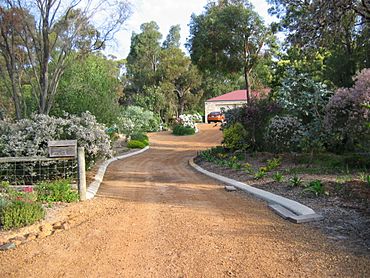Leschenault, Western Australia facts for kids
Quick facts for kids LeschenaultBunbury, Western Australia |
|||||||||||||||
|---|---|---|---|---|---|---|---|---|---|---|---|---|---|---|---|

Typical rural residential lot, on Marine Drive.
|
|||||||||||||||
| Established | 1990s | ||||||||||||||
| Postcode(s) | 6233 | ||||||||||||||
| Area | [convert: needs a number] | ||||||||||||||
| Location | 16 km (10 mi) from Bunbury | ||||||||||||||
| LGA(s) | Shire of Harvey | ||||||||||||||
| State electorate(s) | Leschenault | ||||||||||||||
| Federal Division(s) | Forrest | ||||||||||||||
|
|||||||||||||||
Leschenault is a suburb located about 6 kilometers northeast of Australind, Western Australia. It's part of the Shire of Harvey, which is its local government area. Leschenault is known for having higher-priced homes and a generally well-off community.
Contents
History of Leschenault
How Leschenault Got Its Name
The name Leschenault honors a French scientist named Jean Baptiste Leschenault de la Tour. He was a botanist, which means he studied plants. Jean Baptiste was part of a famous trip led by Nicolas Baudin in 1802–1803. During this trip, they explored the coast, including the Leschenault Estuary and nearby rivers.
However, the very first time someone from Europe reported seeing this coast was much earlier. In 1658, Captain A.P. Jonk from the Dutch East India Company (VOC) saw the land while looking for a lost ship. He didn't land, but he noted the sighting.
From Farmland to Homes
For a long time, until the 1980s, Leschenault was mostly used for farming, like grazing animals. Some people built holiday homes along Cathedral Drive, but the area was largely undeveloped.
In the mid-1980s, plans were made for a new industrial park nearby in Kemerton. This made people more interested in buying land in Leschenault for homes. During the 1990s, more facilities were built in Australind, and a new road called the Australind Bypass was constructed.
Most of the land in Leschenault was then divided into large blocks for homes. These areas were called rural residential estates, like Ashmere Heights and Parklands Estate. These estates often had large lots for houses, separated by natural areas and parks.
The 2006 Tornado
On August 7, 2006, a small tornado hit a part of Leschenault, specifically the Marine Drive area. It was about 200 meters long and 100 meters wide. The tornado damaged 60 houses. Twenty of these houses were so badly damaged that people couldn't live in them, and seven homes lost their roofs completely.
Even though it was a tough time, the community worked together to help the families affected. The nearby Leschenault Leisure Centre in Australind was used as an emergency camp for those who couldn't go home. The government also promised to provide aid to help with the recovery.
Geography of Leschenault
Leschenault has natural borders that help define its area. To the south, it's bordered by the Brunswick River and the Old Coast Road. The Leschenault Estuary forms its western border. To the east, you'll find the Australind Bypass, which is part of National Route 1.
According to the latest census, about 3,058 people live in Leschenault.
Facilities in Leschenault
Leschenault itself doesn't have many shops or schools. Residents usually go to the neighboring town of Australind for their educational and shopping needs.
However, Leschenault does have several caravan parks and bed and breakfasts (B&Bs) for visitors. There's also a community center called Settlers' Hall on Marine Drive, which is a central spot for meetings and events. Some northern parts of the suburb offer access to the Leschenault Peninsula Conservation Park, a great place for nature. The region's rubbish tip is also located nearby, just off the Australind Bypass.
Transport in Leschenault
Getting around Leschenault using public transport can be a bit limited. While there aren't many direct public bus services within Leschenault, Transperth services are available in Galway Green, which is just south of Leschenault. School buses do operate within the suburb to help students get to and from school.
Images for kids




